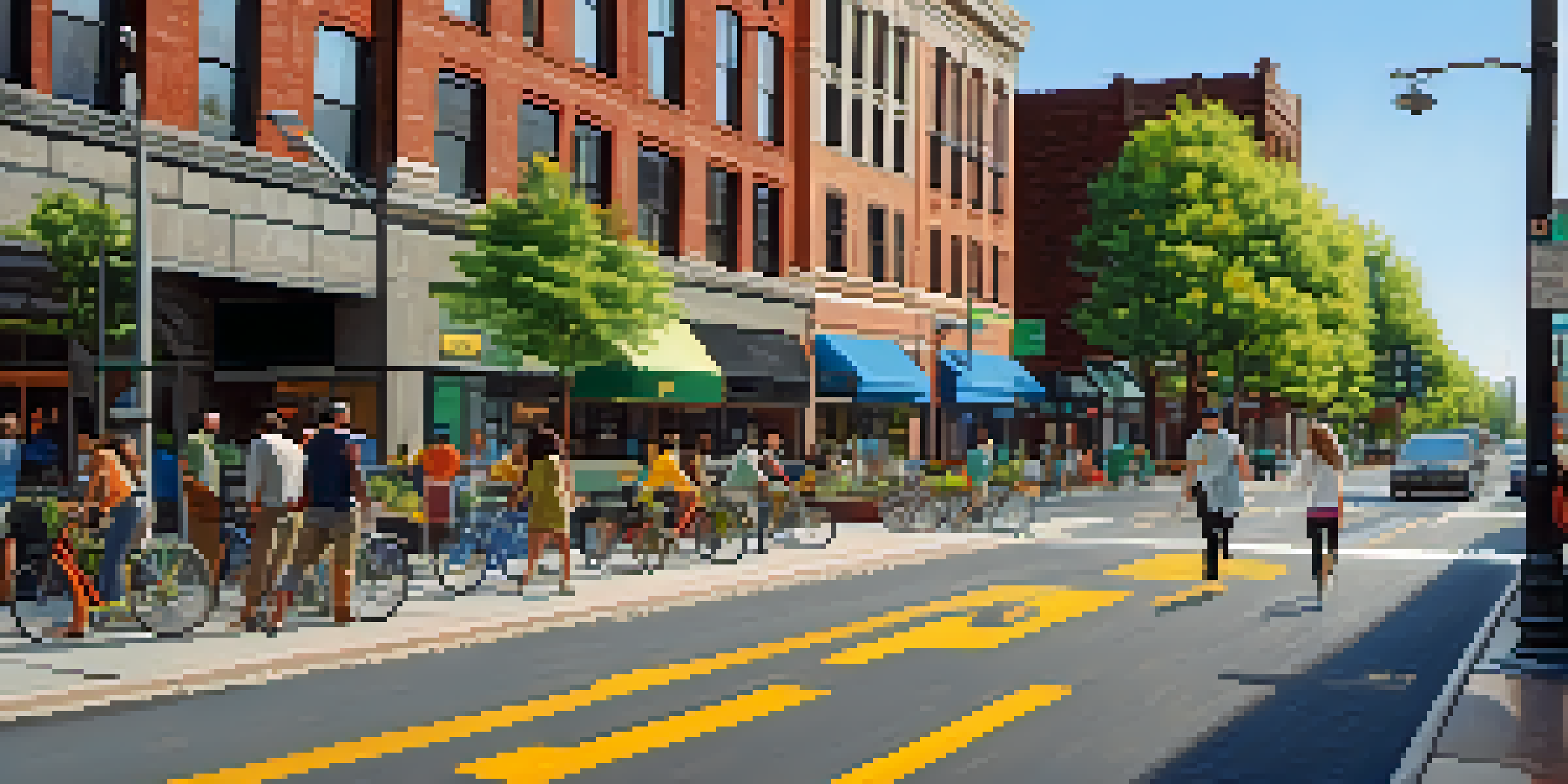Sustainable Transportation in Buffalo: Policies and Progress

Understanding Sustainable Transportation in Buffalo
Sustainable transportation refers to methods of moving people and goods that are environmentally friendly, economically viable, and socially equitable. In Buffalo, this concept is gaining traction as residents and local authorities recognize the importance of reducing carbon emissions and improving public health. By prioritizing sustainable options, Buffalo aims to create a more livable city for its residents and future generations.
Sustainable transportation is not just about reducing our carbon footprint; it's about creating a better quality of life for everyone in our community.
The city’s approach to sustainable transportation encompasses various modes, including walking, cycling, public transit, and electric vehicles. Each of these modes offers unique benefits that contribute to a greener urban environment. For instance, promoting cycling can reduce traffic congestion while also encouraging a healthier lifestyle for residents.
Moreover, sustainable transportation policies often intersect with urban planning efforts. By designing cities that prioritize public transport and non-motorized options, Buffalo can enhance accessibility for all residents. This not only supports sustainability goals but also fosters a sense of community and connectedness among citizens.
Current Policies Supporting Sustainable Transportation
Buffalo has implemented several key policies aimed at promoting sustainable transportation. The city’s Complete Streets policy, for example, focuses on creating roadways that safely accommodate all users, including pedestrians, cyclists, and drivers. This approach ensures that transportation infrastructure is designed to support various modes of travel, making it safer and more accessible for everyone.

Additionally, Buffalo’s Green Code encourages mixed-use development, which can reduce the need for long car trips. By integrating residential, commercial, and recreational spaces, residents can walk or bike to their destinations rather than relying solely on automobiles. This policy shift is essential for fostering a more sustainable urban environment.
Buffalo's Sustainable Transport Vision
Buffalo is prioritizing environmentally friendly transportation options to reduce carbon emissions and improve public health.
The city is also investing in electric vehicle (EV) infrastructure, including charging stations and incentives for EV adoption. As more residents choose electric vehicles, the demand for fossil fuels decreases, contributing to lower greenhouse gas emissions. This is a vital step toward meeting Buffalo's sustainability goals and enhancing air quality in the region.
Progress in Public Transit Systems
Buffalo's public transit system is an integral part of its sustainable transportation strategy. The Niagara Frontier Transportation Authority (NFTA) operates buses and light rail services that provide residents with reliable alternatives to driving. By improving the efficiency and coverage of these services, Buffalo aims to increase ridership and reduce traffic congestion.
The future of urban transportation lies in our ability to integrate eco-friendly options that benefit both the environment and the economy.
Recent enhancements include the introduction of bus rapid transit (BRT) lines, which offer faster and more reliable service. This service model mimics the efficiency of light rail while utilizing existing roadways. By streamlining public transit, Buffalo encourages more residents to opt for these sustainable travel options over personal vehicles.
Moreover, initiatives like the Transit Oriented Development (TOD) promote building residential and commercial spaces near transit hubs. This not only makes it more convenient for residents to use public transport but also supports local businesses. As more people embrace public transit, Buffalo can move closer to its sustainability targets.
Encouraging Biking and Walking in the City
Biking and walking are vital components of Buffalo's sustainable transportation efforts. The city has made significant investments in expanding bike lanes and pedestrian pathways, creating safer and more inviting environments for non-motorized travel. These enhancements encourage residents to choose biking or walking over driving, which aligns with sustainability objectives.
Community initiatives, such as bike-sharing programs and walking events, further promote these modes of transportation. By providing residents with access to bikes and organizing group walks, Buffalo fosters a culture that values active transportation. This not only helps reduce emissions but also promotes health and well-being among the community.
Key Policies Promote Eco-Friendly Travel
The city's Complete Streets policy and Green Code encourage diverse transportation methods and mixed-use developments.
Public awareness campaigns also play a crucial role in encouraging biking and walking. By educating residents about the benefits of these modes and how to navigate the city safely, Buffalo can inspire more people to leave their cars at home. This collective shift can have a profound impact on reducing the city’s overall carbon footprint.
Advancements in Electric Vehicle Adoption
Electric vehicle (EV) adoption is on the rise in Buffalo, thanks to initiatives aimed at making EVs more accessible and appealing. The city is working to expand its network of charging stations, making it easier for residents to transition from traditional vehicles to electric ones. This infrastructure development is essential for supporting the growing number of EV users.
Incentives such as tax credits and rebates for EV purchases further encourage residents to consider electric options. Buffalo is also promoting partnerships with local businesses to install charging stations at workplaces and shopping areas, making it convenient for EV owners to charge their vehicles while they go about their daily activities.
The shift towards electric vehicles is not only about reducing emissions but also about embracing technological advancements. As Buffalo positions itself as a forward-thinking city, the promotion of EVs aligns with broader sustainability goals while enhancing the quality of life for its residents.
Community Involvement and Engagement
Community involvement is crucial for the success of sustainable transportation initiatives in Buffalo. Local organizations and advocacy groups are actively working to raise awareness and engage residents in discussions about transportation options. This grassroots approach ensures that policies reflect the needs and desires of the community, fostering a sense of ownership and responsibility.
Public forums and workshops allow residents to voice their opinions on transportation policies and express their concerns. These events serve as platforms for collaboration between city officials and community members, leading to more effective and inclusive solutions. When residents feel heard, they are more likely to support and participate in sustainable transportation initiatives.
Community Engagement Drives Change
Active community involvement is essential for shaping sustainable transportation initiatives and fostering ownership among residents.
Additionally, educational programs in schools and community centers promote the importance of sustainable transportation from a young age. By instilling these values early on, Buffalo is nurturing a generation of environmentally conscious citizens who prioritize sustainable travel methods. This long-term investment in community engagement is vital for achieving lasting change.
Future Goals for Sustainable Transportation
As Buffalo looks to the future, the city has set ambitious goals for sustainable transportation. One of the key objectives is to increase the share of trips made by walking, biking, and public transit. By establishing measurable targets, Buffalo aims to track progress and hold itself accountable for its sustainability commitments.
Additionally, the city plans to enhance its infrastructure further by exploring innovative transportation solutions, such as autonomous vehicles and smart traffic management systems. These advancements could improve efficiency and safety on the roads, making sustainable options even more attractive to residents.

Community collaboration will remain a cornerstone of Buffalo's sustainable transportation strategy. By continuing to engage residents and stakeholders in the planning process, the city can ensure that its initiatives are relevant and effective. Together, Buffalo is paving the way for a more sustainable and connected future.